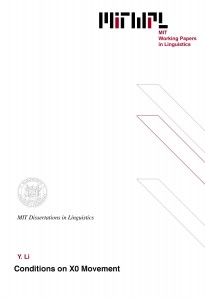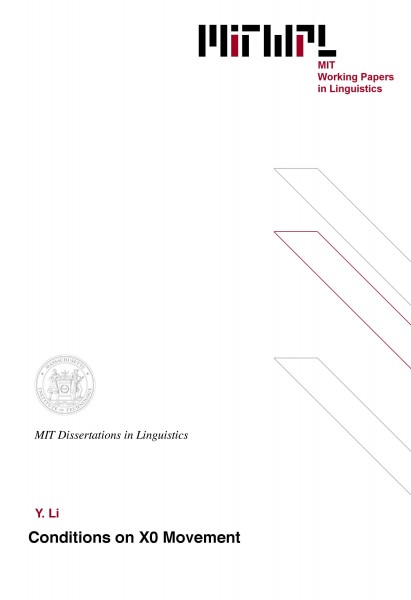Conditions on X0 Movement
Y. Li, 1990
X0-movement is subject not only to the Empty Category Principle (ECP), as is widely accepted now, but also to Binding Condition C (BCC) and the Subjacency Condition (SC). Theoretically, this proposal is preferred because behaviorally X0-movement is brought even closer to XP-movement, which is also constrained by all these principles. Empirically, we are now allowed not only to explain certain data which are not explained in a theory based solely on the ECP, but also to provide a unified analysis to verb-incorporation (VI), clitic-climbing (CC), and predicate-clefting (PC).
Theoretical background is laid out in Chapter 1, in which the notion of variables is modified to cover X0-traces resulting from moving a lexical head to a functional head. This in turn enables such an X0-trace to fall into the domain of BCC. In Chapter 2, it is shown that the fact that crosslinguistically only a small number of verbs can ever trigger VI poses a problem if X0-movement is constrained only by the ECP, but can be readily accounted for by BCC plus the modified definition of variables. The environments in which CC takes place are also highly limited but constitute a superset of those for VI. Chapter 3 argues that the similar requirements of the two phenomena on theirr structural environments is the result of BCC, while the difference derives from the possibility of applying the SC and intermediate trace deletion in the derivation of CC but not in VI. An even looser restriciton on the environments is observed for PC, studied in Chapter 4. Again BCC and SC play crucial rules in determining when PC is possible, with the looser constraint attributed to the presence of a resumptive verb filling the D-structure position of the clefted one.
Thesis Supervisor: Kenneth Hale
Title: Ferrari P. Ward Professor of Modern Languages and Linguistics
Table of Contents
Chapter 1 Introduction 1
1.1 Universal grammar 2
1.1.1 X"-theory 3
1.1.2 Theta-theory 4
1.1.3 Government theory 4
1.1.4 Bounding theory 9
1.1.5 Binding theory 10
1.1.6 Case theory 14
1.1.7 Control theory 18
1.2 Organization of the thesis 20
Chapter 2 Incorporation 22
2.1 Solutions to problems 24
2.1.1 Apparent solutions which don"t work 24
2.1.2 CP complement vs. VP complement 27
2.1.3 Analysis outlined 31
2.2 Applications 33
2.2.1 Two types of causativization 33
2.2.2 Passivization 51
2.2.3 Negation 59
2.2.4 Other VI triggering verbs " modal-like verbs 62
2.2.5 Other VI triggering verbs " bridge verbs in Eskimo 66
2.2.6 V-de construction in Chinese 71
2.2.7 VI in the lexicon 74
2.3 Perception verbs 76
Chapter 3 Clitic-climbing 78
3.1 Intermediate trace deletion in head-movement 82
3.2 Causatives in French and Italian 87
3.2.1 Two types of faire-VP constructions 88
3.2.2 FI constructions 90
3.2.3 FP constructions 98
3.3 Restructuring constructions 102
3.3.1 Structure of restructuring constructions 102
3.3.2 Infinitive INFL 109
3.3.3 Raising vs. control 116
3.4 Exceptional case marking and negation 124
3.4.1 ECM 124
3.4.2 Negation 135
3.5 Other clitics: en and y 141
Chapter 4 Predicate-cleftin 145
4.1 Data 146
4.1.1 Predicate-clefting as V-movement 147
4.1.2 Predicate-clefting vs. clitic-climbing 151
4.2 Koopman"s (1984) analysis of predicate-clefting in Vata 155
4.3 Predicate-clefting reanalyzed 162
4.3.1 Infinitives 162
4.3.2 Wh-island 172
4.3.3 Non-bridge verbs 176
4.3.4 Bridge verbs 180
4.3.5 Clitic-climbing 191

